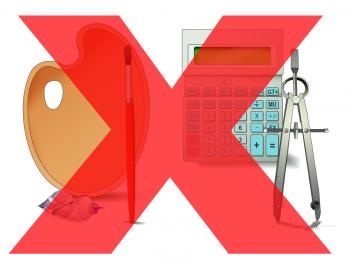Chapter 2. How Would You Know If People Can Be “Left-Brained” or “Right-Brained”?
2.1
By:
C. Nathan DeWall, University of Kentucky
David G. Myers, Hope College

2.2
Note: You will be guided through the Intro, Design, Measure, Interpret, Conclusion, and Quiz sections of this activity. You can see your progress highlighted in the non-clickable, navigational list at the right.
Watch this video from your author, David Myers, for a helpful, very brief overview of the activity.
2.3

So, how would you know if people can be "left-brained" or "right-brained"? This could be a question about personality or "preferred thinking style," but instead let's focus the question on the capabilities of the two brain hemispheres: Do people use the left hemisphere or the right hemisphere--or both--when reading words? To study this question effectively in your role as researcher, you need to DESIGN an appropriate study that will lead to meaningful results, MEASURE use of the left brain and right brain in your participants, and INTERPRET the larger meaning of your results, considering how your findings would apply to the population as a whole.
We will start by choosing a good research DESIGN. From the following options, select the best design for studying whether people are left-brained or right-brained.
| A. |
| B. |
| C. |
Click on "Video Hint" below to see brief animations describing Correlational Studies, Experiments, and Case Studies.
Video Hint
2.4
Correlational Studies:
Experiments:
Case Studies:
2.5

You have chosen a Correlational design, which means you want to examine the association between two or more variables. For example, when testing whether height is related to weight, researchers would recruit a large group of people and measure their height and weight. This allows researchers to determine whether having more height predicts having more weight. (It does.)
Describe below how you would set up your correlational study to determine if people can be left-brained or right-brained:
2.6

With a Correlational design, we might examine the association between personality type and enjoyment of various activities, such as mathematical equations and artistic expression, to determine if someone can be left- or right-brained. As a result, we would learn something about the relationship between personality and various interests, but we could not learn whether someone was truly left-brained (primarily using the left side of their brain) or right-brained (primarily using the right side) based on the activities they like. Many factors contribute to what we decide we like, including learned positive or negative associations, presented opportunities, and likable people modeling certain behaviors. We could gather some information from this design, but it’s not the best approach. We need to determine whether people use their left brain hemisphere, their right brain hemisphere, or both hemispheres.
So, CORRELATIONAL IS NOT THE BEST RESEARCH DESIGN for this study. We’d get more helpful results by using a different design. Click “Next” to go back and try again to select the most effective research design.
2.7

You have chosen Case Study as your design. With a Case Study design, you will choose one person or a small group of people, such as a specific group of people who have certain neurological characteristics, and then study them in depth.
Of the following options, which one represents the best person or persons for your study? (Note that a corpus callosum helps the left and right brain hemispheres communicate.)
| A. |
| B. |
| C. |
| D. |
2.8

What could we learn from these participant choices?
One person or a small group of people who have a fully functional left brain hemisphere but are missing part of the right brain hemisphere You would need to recruit people who have fully functioning left and right brain hemispheres. This way you can determine whether people use their left hemisphere, right hemisphere, or both hemispheres.
One person or a small group of people who are missing part of the left brain hemisphere but have a fully functional right brain hemisphere You would need to recruit people who have fully functioning left and right brain hemispheres. This way you can determine whether people use their left hemisphere, right hemisphere, or both hemispheres.
One person or a small group of people who HAVE a fully functional corpus callosum You were right to select participants with a fully functioning corpus callosum. However, studying only one individual or a small group of people would not help you learn about the functioning of brain hemispheres in the broader population.
One person or a group of people who DO NOT HAVE a fully functional corpus callosum To be able to apply your findings to a larger population, it is important to select participants who have healthy brain structure and function. If people do not have a functioning corpus callosum, you cannot determine whether their left and right brain hemispheres work together or independently.
Trying to choose a participant sample helps us realize that the CASE STUDY IS NOT THE BEST RESEARCH DESIGN to test this question. We’d get more helpful results by studying large groups of people who have healthy brains, which would allow us to apply our results to a broad population. We would also want to measure performance of the left and right brain hemispheres in a controlled setting. This would help us determine whether people can be left-brained or right-brained.
Click “Next” to go back and try again to select the most effective research design.
2.9

Nice work! You have correctly chosen to use an Experimental design for your study.
Next, you need to choose the most appropriate study participants.
Of the following options, which one represents the best group for your study? (Note that a corpus callosum helps the left and right brain hemispheres communicate.)
| A. |
| B. |
| C. |
2.10

This group is not the best choice, because you need to recruit people who have fully functioning left and right brain hemispheres. This way you can determine whether people use their left hemisphere, right hemisphere, or both hemispheres.
Click “Next” to try again to choose the most appropriate study participants.
2.11

This group is not the best choice, because you need to recruit people who have fully functioning left and right brain hemispheres. This way you can determine whether people use their left hemisphere, right hemisphere, or both hemispheres.
Click “Next” to try again to choose the most appropriate study participants.
2.12

Good job! You have correctly chosen to use an Experimental Design, and you’ve selected an appropriate sample of participants - people who have intact brain hemispheres and a corpus callosum, which helps the two hemispheres work together to solve problems. Now you need to determine how best to MEASURE the relevant behavior or mental process, which in this case is left-brain and right-brain responding - the idea that people use their left brain hemisphere, right brain hemisphere, or both hemispheres.
But first, it’s important to REMEMBER THE PECULIAR NATURE OF OUR VISUAL WIRING: Information from the left half of your field of vision goes to your right brain hemisphere, and information from the right half of your visual field goes to your left brain hemisphere. Click “Next” for a review of our visual wiring.
2.13
After reading the review material from the text below, click “Next” to select a good way to measure the target behaviors for your activity.

2.14
With your newly reinforced understanding of the basics of our visual processing, it’s time now to determine the best way to MEASURE whether people use the left hemisphere or the right hemisphere or both when reading words from a screen. This will help you answer, in one very basic way, whether people can be "left-brained" or "right-brained."
Of the following options, which one represents the best way to measure whether people use their left brain hemisphere, right brain hemisphere, or both brain hemispheres?
| A. |
| B. |
| C. |
2.15

You chose Have participants focus on a center point, then identify a word that has been presented to the left half (i.e., right brain hemisphere) but NOT the right half (i.e., left brain hemisphere) of their field of vision, but that is NOT CORRECT.
This option would tell you something about whether people could use their right brain hemisphere, but it would not give you the information you need about whether they could use their left brain hemisphere. To know whether people can be left-brained or right-brained, it is necessary to measure information that is presented to their left and right brain hemispheres.
Click “Next” to try again to select the best way to measure whether people can be left-brained or right-brained.
2.16

You chose Have participants focus on a center point, then identify a word that has NOT been presented to the left half (i.e., right brain hemisphere), but has been presented to the right half (i.e., left brain hemisphere) of their field of vision, but that is NOT CORRECT.
This option would give you information about whether people could use their left brain hemisphere, but it would not tell you whether they could use their right brain hemisphere. If you want to know whether people can be left-brained or right-brained, you need to measure information that is presented to their left and right brain hemispheres.
Click “Next” to try again to select the best way to measure whether people can be left-brained or right-brained.
2.17
Good job! You have correctly chosen to use an Experimental design, and you’ve selected an appropriate group of participants—a sample of people who have two functional hemispheres and a functional corpus callosum. You’ve also chosen an effective way to MEASURE whether people use their left brain hemisphere, right brain hemisphere, or both hemispheres. You chose to Have participants focus on a center point, then identify a word that has been presented to both the left half (i.e., right brain hemisphere) and right half (i.e., left brain hemisphere) of their field of vision.

In similar studies, researchers have in fact found that participants with intact, connected hemispheres demonstrate that they are using both sides of their brain. They report seeing “pancake” and not just “pan” (which would indicate that only the right hemisphere has been activated) or “cake” (which would indicate that only the left hemisphere has been activated) (Gazzaniga, 1983). If our whole brain is involved in our processing, then we can’t really be “right-brained” or “left-brained,” can we?
While some areas of each hemisphere do specialize in different tasks (such as language in the left hemisphere and emotion processing in the right hemisphere), the brain’s two sides collaborate to enable whatever we do.
Knowing this, you need to consider how you can apply what you’ve learned to the larger population—beyond the people you’ve studied. Consider where you might encounter roadblocks to confidence in your results. What factors might keep you from being able to apply what you’ve learned in a broader context?
2.18

You tested whether people use their left brain hemisphere, right brain hemisphere, or both hemispheres. There are many factors that could affect how people complete your measure of brain hemisphere processing, and these factors may have nothing to do with whether people are "left-brained" or "right-brained"! Factors that could interfere with your INTERPRETATION of results are called confounding variables.
From the following options, select the factors that could affect performance on this word-reading task.
| Fluency in English | |
| Enjoyment of true crime podcasts | |
| Whether participants wear their prescription contacts or eyeglasses | |
| Knowledge of neuroscience | |
| Excitement about being a participant in a psychological study | |
| Brain damage |
Click on "Video Hint" below to see a brief animation describing Confounding Variables.
Video Hint
2.19
Confounding Variables:
2.20
| Fluency in English | |
| Enjoyment of true crime podcasts | |
| Whether participants wear their prescription contacts or eyeglasses | |
| Knowledge of neuroscience | |
| Excitement about being a participant in a psychological study | |
| Brain damage |
The highlighted confounding variables relate to your participants’ ability to read the word you show them. If they do not speak English fluently, they might not be familiar with the word you show them and have difficulty reading it. Participants who forget to wear their prescription contacts or eyeglasses, or those with brain damage from a stroke or other cause, may also struggle to see the word you show. Neither knowledge of neuroscience nor excitement about participating in your study should affect whether participants can use their left and right brain hemispheres. Unless you keep track of the highlighted confounding variables—in this case by ensuring that those with these issues do not participate—you might draw incorrect conclusions about your study results.
2.21
You may do better on the Quiz if you take notes while watching this video. Feel free to pause the video or re-watch it as often as you like.
REFERENCES
Gazzaniga, M. S. (1983). Right hemisphere language following brain bisection: A 20–year perspective. American Psychologist, 38, 525–537.
Gazzaniga, M. S. (1988). Organization of the human brain. Science, 245, 947–952.
Roser, M. E., Fiser, J., Aslin, R. N., & Gazzaniga, M. S. (2011). Right hemisphere dominance in visual statistical learning. Journal of Cognitive Neuroscience, 23, 1088-1099.
2.22
QUIZ: NOW WHAT DO YOU KNOW?
1. Why was it important to use an experimental design?
| A. |
| B. |
| C. |
| D. |
2. In your study, whether participants spoke English fluently was a confounding variable because:
| A. |
| B. |
| C. |
| D. |
3. Why was it a good idea to measure responses of a group of people rather than a single person or small group of people?
| A. |
| B. |
| C. |
| D. |
4. Why did you present information to both the left and right field of vision?
| A. |
| B. |
| C. |
| D. |
5. If someone asked you whether people can be left-brained or right-brained, how might you respond based on what you learned in this activity? (5 points)